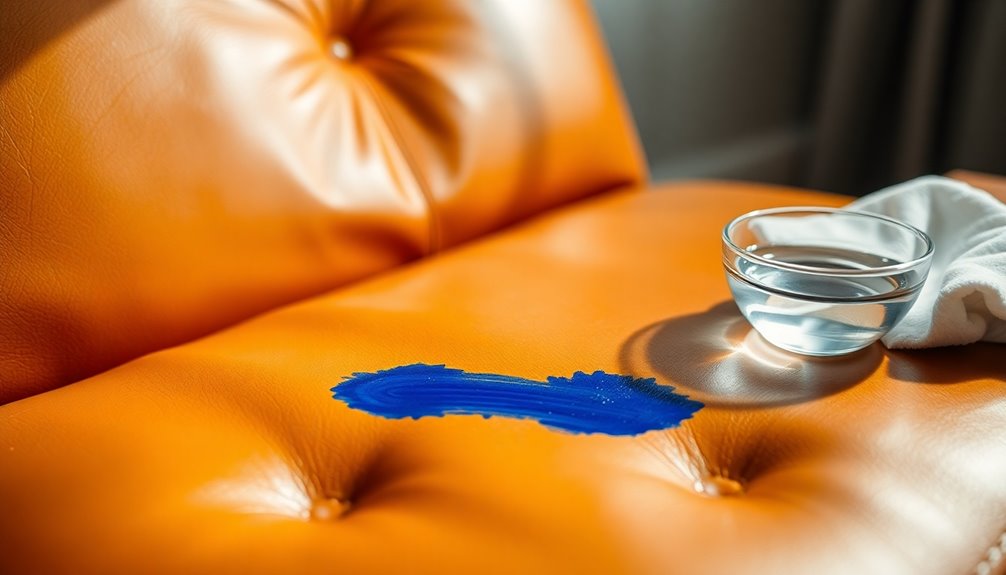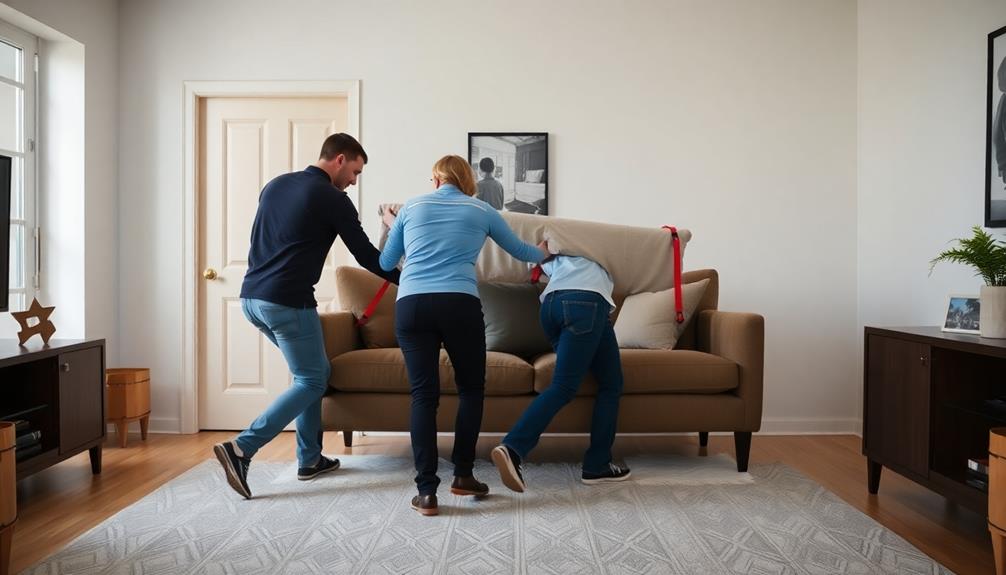To remove ballpoint ink from your leather sofa, start by gently blotting the stain with a clean cloth. If it's fresh, act quickly. You can dab a cotton swab soaked in rubbing alcohol onto the ink, but be cautious as this may strip color. Alternatively, use a commercial leather product designed for ink removal. If you prefer a gentler approach, mix mild dish soap with warm water, apply it with a soft cloth, and wipe in circles. After cleaning, dry the area and apply a leather conditioner to restore moisture. You'll find more tips for proper care soon.
Key Takeaways
- Identify the type of ink and leather before starting the cleaning process to ensure the best method is used.
- Blot the ink stain gently with a clean cotton cloth to absorb as much ink as possible before applying any cleaning solution.
- Use rubbing alcohol carefully, dabbing it on the stain with a cotton swab, and follow up with a leather conditioner.
- Consider using commercial leather products specifically designed for ink removal, testing on an inconspicuous area first.
- After cleaning, dry the leather and apply a conditioner to restore moisture and protect against future stains.
Identifying and Preparing the Stain

When you spot a ballpoint ink stain on your leather sofa, the first step is identifying and preparing the area for cleaning. Start by determining the type of ink, as this will guide your cleaning method. Check if the stain is fresh or dried; fresh stains are much easier to tackle. Next, identify the type of leather—whether it's aniline, semi-aniline, or pigmented—to avoid using harsh cleaners that could damage it. Assess the size and location of the stain to plan your approach effectively, and keep the color of the leather in mind to prevent any discoloration during the cleaning process.
Before diving into cleaning, blot the stain gently with a clean cotton cloth to absorb as much ink as possible. Always test any cleaning solution on an inconspicuous area first, ensuring it won't harm the leather. Clear the surrounding area to prevent the stain from spreading, and use a microfiber or soft cloth to avoid scratching the surface. Lastly, ensure good ventilation while you work, especially if you'll be using chemical cleaners. This preparation lays the groundwork for successfully removing that ink stain. Additionally, using a leather cleaner specifically formulated for ink removal can enhance your chances of effectively treating the stain.
Using Rubbing Alcohol

Using rubbing alcohol can be an effective method for tackling ballpoint ink stains on your leather sofa, but caution is essential. Rubbing alcohol can strip the color from the leather, leading to bleached areas that may require a full refinish. Additionally, it can dry out the leather, making it brittle and prone to cracking over time.
To start, dab a cotton swab soaked in rubbing alcohol onto the ink stain. This helps avoid spreading the stain further. Before applying the alcohol, use a clean white cloth or paper towel to remove any excess ink. It's crucial to dampen the cloth with the alcohol solution instead of applying it directly to the leather. Once you've treated the stain, use a blow dryer on a low setting to dry the area, which helps prevent additional damage.
Always test the rubbing alcohol on an inconspicuous area first to ensure it won't harm the leather. While isopropyl alcohol is the safest option, it can still cause damage. After treating the stain, consider following up with a leather conditioner to restore moisture and maintain your sofa's appearance. Additionally, multiple methods exist due to various types of commercial inks, so exploring alternatives may also be beneficial.
Applying Commercial Leather Products

Rubbing alcohol can be a useful tool for ink removal, but if you're looking for a safer, more effective option, consider applying commercial leather products specifically formulated for this purpose. These dedicated ink removal solutions are designed to efficiently lift ink from leather without causing damage. It's important to determine the size of the ink stain before selecting your cleaning method, as this can influence the effectiveness of the treatment.
When using these products, you'll often find kits that include cotton swabs, microfiber towels, and leather finishing cream. Before you start, always test the solution in an inconspicuous area to ensure it's compatible with your leather. To apply, dip a cotton swab in the solution and gently dab it on the ink stain, then wipe away with a microfiber towel. If the stain is heavy, you might need multiple applications.
For added protection, consider using Leather Master Ink Stop, which prevents ink from penetrating the leather's surface. This product also helps guard against other stains and wear. After cleaning, don't forget to apply leather conditioner to restore moisture and appearance. Simply rub a little conditioner into the area, let it soak for a few minutes, and wipe away with a clean cloth for a rejuvenated look.
Using Mild Soap and Water

Mild soap and water can be an effective and gentle solution for removing ballpoint ink from your leather sofa. Start by preparing your soap solution. In a small bowl, mix a couple of drops of mild, clear dish soap with warm water. Make sure the soap is unscented or mild to avoid damaging the leather. Plant-derived soaps can also work well for this purpose. Immediate action is crucial, as it yields better results than waiting for stains to set.
Next, dip a soft, lint-free cloth into your soapy solution, then wring out the excess water. You want the cloth damp, not soaking wet, to prevent any moisture damage. Gently rub the ink stain in a circular motion, focusing solely on the stained area. Avoid applying too much pressure, as this might damage the leather.
After treating the stain, it's crucial to remove any soap residue. Wipe the area with a clean, damp cloth and blot it to prevent the stain from spreading. Rinse the cloth and repeat as necessary until all soap is removed. Finally, pat the area dry with a clean cloth, ensuring no moisture lingers that could harm your leather sofa.
Post-Cleaning Care and Precautions

After successfully removing the ink stain from your leather sofa, it's important to focus on post-cleaning care to keep your furniture looking its best. Start by drying the leather. Use a dry cloth to blot the area and remove any excess moisture, then allow the leather to air dry completely in a well-ventilated area. Avoid using heat, as it can damage the material.
Next, apply a leather conditioner using a microfiber cloth. Massage it into the leather to restore moisture and essential oils. Aim to condition the leather at least twice a year, adjusting for your climate. Regular conditioning is essential for maintaining the suppleness of all leather types.
Be cautious with cleaning products. Never use harsh cleaners or abrasive materials like bleach or rough sponges. Stick to gentle, pH-balanced cleaners designed for leather care, and always test any solution in an inconspicuous area first.
Lastly, maintain your leather sofa with routine care. Dust and vacuum weekly using a brush attachment to clean seams and crevices. Regularly inspect for signs of wear or stains, addressing any issues immediately to prevent lasting damage. Following these steps will help extend the life and beauty of your leather sofa. Consider creating custom sofa covers to protect your leather sofa from spills, pet hair, and direct sunlight. This additional layer of protection can help to keep your sofa looking new for longer, reducing the need for deep cleaning or repairs. By taking these proactive measures, you can enjoy your leather sofa for years to come. Creating custom sofa covers is a great way to add a personal touch to your living space while also providing practical benefits.
Frequently Asked Questions
Can I Use Bleach to Remove Ink Stains From Leather?
You shouldn't use bleach to remove ink stains from leather. It's highly corrosive and can severely damage the material, causing discoloration, cracking, or brittleness. Instead, try isopropyl alcohol or a commercial leather cleaner specifically designed for ink removal. Always test any solution in an inconspicuous area first. Acting quickly is vital to prevent the stain from setting, and applying a leather conditioner afterward will help restore its natural moisture and finish.
Will Removing Ink Stain Damage the Leather's Color?
Yes, removing an ink stain can damage the leather's color if you're not careful. Certain cleaners can react negatively with the leather, particularly if it's aniline or untreated. It's vital that you test any cleaning solution on a hidden area first. Always use a soft cloth and apply gently, as rubbing too hard can worsen the color damage. Taking precautions will help preserve your leather's appearance while tackling the stain effectively.
How Can I Prevent Future Ink Stains on Leather?
To prevent future ink stains on leather, you should regularly apply leather protectants. These create a barrier that stops ink from penetrating the surface. Keep your leather items clean with gentle, leather-specific cleaners, and always conduct a spot test first. Additionally, store pens and other ink sources away from leather. By taking these precautions, you'll maintain your leather's appearance and prolong its life, making it easier to clean if stains do occur.
What Should I Do if the Stain Persists After Cleaning?
If the stain persists after cleaning, don't worry. You can try a few more methods. First, soak a cotton swab in rubbing alcohol and gently dab the stain. Use a blow dryer to evaporate the alcohol quickly. If that doesn't work, mix mild soap with water and let it sit on the stain for a few minutes. Finally, consider professional cleaning if the stain remains stubborn. Always remember to condition the leather afterward!
Are There Any Home Remedies for Ink Removal From Leather?
If you're looking for home remedies to remove ink from leather, you've got a few options. Try mixing equal parts vinegar and water, then dab the solution on the stain. Rubbing alcohol is another effective choice—just test it on a hidden spot first. You can also use a Magic Eraser with a bit of water, but be gentle. Always condition the leather afterward to keep it looking great!
Conclusion
In conclusion, removing ballpoint ink from your leather sofa is doable with the right approach. Whether you choose rubbing alcohol, commercial leather products, or a simple soap-and-water solution, always test in an inconspicuous area first. After cleaning, don't forget to apply a leather conditioner to keep your sofa looking its best. With these tips, you can tackle ink stains confidently and enjoy your beautiful leather furniture for years to come.









